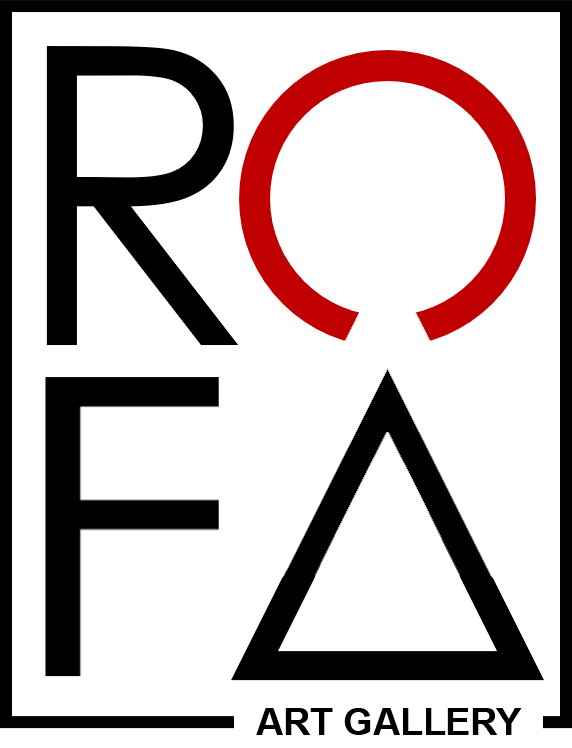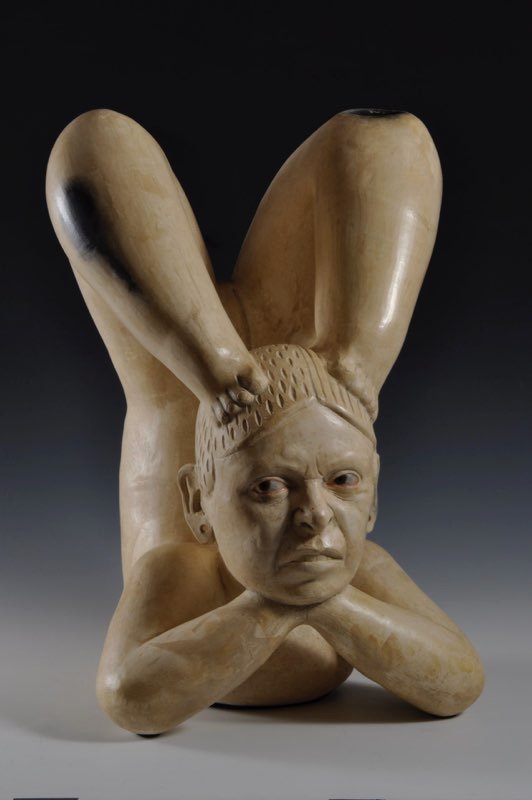Kukuli Velarde
“I am a Peruvian-American artist. My work, which revolves around the consequences of colonization in Latin American contemporary culture, is a visual investigation about aesthetics, cultural survival, and inheritance. I focus on Latin American history, particularly that of Perú, because it is the reality with which I am familiar. I do so, convinced that its complexity has universal characteristics and any conclusion can be understood beyond the frame of its uniqueness.
I base my work in Pre-Columbian ceramic work, not as an act of plunder or appropriation but of recognition and reconnection. And I wish to introduce my work to Western art, not as prop or reference but as an aesthetics that represents a population not reflected on its aesthetics, and to which I belong. I am attempting to portray the paradoxical existence of two worlds that have not fully understood and accepted each other and yet cohabit for centuries within people and landscape, while exposing and questioning contemporary issues such as racism, inferiority complex, social injustice and ethnic and cultural marginalization. My art work is therefore a denunciation of our reality. It is a historical document that speaks of what we were and what we have become.” Kukuli Velarde
CORPUS: Contemporary Art and Historical Identity. A Study of Peruvian Aesthetic Heritage Through Art consists of ceramic sculptures, based on Catholic icons which conform a festivity known as Corpus Christi in Cusco - Perú.
CORPUS narrates the history of Peru, incorporating pre-Columbian and Colonial sensibilities by visually mimicking syncretism within a contemporary narrative. The concern with this issue coincides with the aesthetic and cultural decolonizing actions that are taking place now around the world. Colonization and coloniality have for centuries forced populations to dismiss, among other things, their regional aesthetics, including their understanding of personal beauty. The consequence is the belief that a universal aesthetics exists, though it is actually rooted in European canons of beauty, which do not correspond to all populations. What overwhelms public advertisement and TV programming in Perú are people who have non prominent indigenous features, and do not reflect most of their audience. Unable to find themselves in today’s “universal” aesthetics, many are either creating alternatives that suit their taste or ones that respond to their ancestral history. It is a search for dignity, the one lost through centuries of imposition and disdain.
CORPUS aims to encourage reflection on the meaning of survival of culture in contrast with the existence of culture.
Emphasize the importance of understanding the history of Perú, as a living continuum, which involves a comprehension of the differences between inheritances versus appropriation; one’s own aesthetics versus foreign aesthetics; creating versus following.
Recognize within our conversation about art the existence of other aesthetics besides Western aesthetics in today’s diverse societies, those that are more suited to their populations (historically, socially, physically) and yet are rejected, ignored or undervalued. It comes to mind the Aymara people from El Alto, La Paz. They have achieved economic success and are investing in massive residential construction, creating an architecture that accommodates to their needs, their taste, and their history. Whatever we in the West consider beautiful, interesting, mesmerizing architectural creations mean little to them. They are true to themselves, resistant to conform to an aesthetics that doesn’t reflect them.
A MI VIDA (TO MY VIDA)
“Each piece in this body of work sports my daughter's features when she was 6. I got pregnant at 48 and gave birth a child we named Vida (Life). She has added to my life experience and fed my work in ways I never expected. The idea of creating these intimate works sprouted from my surrendering to parental love and resignation to the emotional pain that will come, when her world shifts away from ours when she grows up.
But A MI VIDA is not just about a mother and the natural, and unavoidable separation from her offspring, The pieces speak of that emotional pain, the pain of separation, including one that is not natural, it is avoidable, and it is unbearable. The project explores separation within the frame of our political landscape. The pain, a thousand times greater, that must overcome a parent, and a child, when separated by force. The project aim to raise awareness about the difficult times immigrants of color are facing today. Each piece aims to become a symbolic representation of every immigrant child out there, isolated and scared, trapped in federal detention centers throughout the country. They are deprived of all demonstration of love and sense of safety, and remain betrayed by our society, which fails to embrace them.
A MI VIDA is a denunciation of the outrageous treatment of their innocent lives, and it is an urgent request for empathy and protection against the pain of imposed separation. My terracotta pieces of pre- Columbian inspiration, are meant to symbolize immigrant children for I am a first generation immigrant, a minority with a child in my arms who can’t understand the cruelty of separating families, amidst a political and social environment that has become, every day, more toxic and unsafe. The pre-Columbian connotation implies the connection that exists between people like me, Westernized individuals from Latin America, and the land we left behind, where civilizations of varied cultural achievements and refined aesthetic developments are part of our history, alongside original communities who stubbornly survive five hundred years of genocide.
“PLUNDER ME, BABY came to be an act of defiance. I always wonder what would happen if pre- columbian ceramics in any museum of the world were to wake up from centuries of sleep, what would they think or feel, out of context and stripped of meaning? What would it be for them to be prisoners in a beautiful display? I imagine them in despair, in pain, in fear, and overcoming their defeat; owning themselves, not anymore victims but witnesses of history, transcending their own existence.
The title of the series is a defiance, a teasing invitation to futile aggression for they are beyond harm. Individually their titles are composed by racial slurs. The ones still very much in use in Perú and Latin America. In addition, since each piece is based in an actual Pre-Columbian figurine, they all have the name of the culture as well as the date that such style was in use.
Pre-Columbian arquitectural marvels in Perú such as Chanchan, a city built entirely out of clay, Chavin de Huantar, the city of Cusco, the Lines and Geoglyphs of Nasca and Pampas de Jumana and the Sacred City of Caral-Supe, have been honored with World Heritage Sites recognitions by Unesco. The China Central Television (CCTV) has launched in 2014, its first national speaking contest in Spanish. The winner of “Spanish Quiz CCTV” will receive a trip to Peru with expenses paid, offered by the Peruvian Embassy in the Asian giant. Many compete for the opportunity to see by themselves the making of my ancestors.
They, the ones who were, can rest in peace, proud of being part of history and contributors of human development worldwide. I am proud of them but that doesn’t make me proud of being Peruvian. We, the heirs have to rise from our own ashes, stripe ourselves of self-hatred, embrace each other, and become again, the centers of our universe.”
Kukuli Velarde
BIO. Kukuli Velarde (Perú, 1962)
Selected Solo Exhibitions: CORPUS, The Southeastern Center for Contemporary Art, Winston-Salem, NC, (2023); CORPUS, Rusell Hills Rogers Galleries, UTSA Southwest, San Antonio, TX (2022); CORPUS, Halsey Institute of Contemporary Art at College of Charleston, Charleston, SC (2022); THE COMPLICIT EYE, Taller, Philadelphia, PA (2018); KUKULI VELARDE, AMOCA, Pomona, CA (2017); PLUNDER ME, BABY, Nerman Museum of Contemporary Art, Kansas City, KS (2013); PATRIMONIO. Germán Krüger Espantoso Gallery, ICPNA, Lima, Perú (2012); PATRIMONIO, Barry Friedman, New York, NY (2010); PLUNDER ME, BABY, work in progress, Garth Clark Gallery, New York, NY (2007); ISICHAPUITU, final presentation, John Michael Kohler Arts Center, Sheboygan, WI (2001); KUKULI VELARDE, From ISICHAPUITU and PURE LOVE series, Invited Artist, International Biennial of Lima, Peru (1999); among others.
Selected Group Exhibitions: CORPUS, Hermitage Exhibition, Sarasota Museum, Florida (2024); Made in PA, Palmer Museum, State College, PA (2024); Re-Collections, The Latinx Project, Gallery, NYU, New York City (2024); Evade or Ensnare: Decorative Illusionism in Historic and Contemporary Painting, PAFA, Philadelphia, PA (2023); International Ceramic Art Fair, Gardiner Museum, Toronto, Ontario (2022); In Dialogue, Exhibition with Cristina Córdoba, Ferrin Contemporary, North Adams, MA (2021); El Perú: Art in the Contemporary Past, 4 Peruvian Artists, National Hispanic Art Museum, Albuquerque, NM (2019); KUKULI VELARDE/LIANE LANG, James Freeman Gallery, London, UK (2018); CORPUS video, Mercosul Biennial, Porto Alegre, Brazil (2015); PLUNDER ME, BABY, Ceramic Biennial of Taipei, Yingge Museum, Taipei, Taiwan (2014); Gyeonggi International Ceramic Biennial, Invited Artist, South Korea (2013); Ev+a 2005, Limerick, Ireland (2005); Form and Contents: Corporal Identity- Body Language, Museum fur Angewandte Kunst, Frankfurt, Germany (2004); Artists from the Bronx, Bronx Museum, Bronx, NY (1996); among others.
Selected Collections: The Renwick Gallery of the Smithsonian American Art Museum, Washington DC; The Museum of the Art Institute of Chicago, Chicago, Illinois; PAFA Pennsylvania Academy of the Fine Arts Museum, Philadelphia, PA; Museum of Fine Arts, Houston, TX; Woodmere Art Museum, PA; Museo de Arte Contemporaneo de Lima MAC, Lima, Perú; Maier Museum of Fine Arts, Randolph College, Lynchbuig, VA; Racine Art Museum, Racine, WI; John Michael Kohler Arts Center, Sheboygan, WI; Fuller Craft Museum, Brockton, MA; Crocker Museum, Sacramento, CA; Yingge Museum of Ceramics, Taiwan; among others.




































